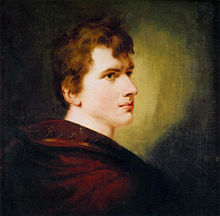The great invalid at Fort Ratonneau
The great invalid at Fort Ratonneau is a story by Achim von Arnim that appeared in the Almanac Gaben der Milde in Berlin in 1818 .
Rosalie's love heals Francœur's illness.
content
During the Seven Years' War the young French Sergeant Francœur met and fell in love with Miss Rosalie Lilie while he was imprisoned on the outskirts of Leipzig. In the Pleissenburg, Rosalie had taken care of the sergeant, who was wounded in the head, against her mother's wishes. The couple had married. Rosalie follows Francœur to Marseille and gives birth to a child. With Count Dürande, the commandant of the city, Rosalie stands up for the sick husband without the knowledge of the proud Francœur. Although Francœur has gone mad because of his war injury , he still gets command of two invalids from the Count on the nearby island of Ratonneau . The valet Basset, an old comrade of Francœur's regiment, learns of his count's conversation with Rosalie. The talkative basset hound visits Francœur on Fort Ratonneau and talks about everything. Francœur does not want to owe his position to a woman. In a terrible outburst of anger, he chases away his beloved woman, his own child and his two subordinates. The madman declares war on the count and thus also on the city of Marseille. The sergeant wants to blow himself up with the powder tower in case the enemy gets too close. Francœur is not kidding. In a one-man war, he blocks the sea route to Marseille with his cannons. The city's supply stagnates. Count Dürande must act. Rosalie steps in. The young woman wants to bring her mad husband to reason. The count thinks this is impossible because an outpost told him that Francœur above all hates his wife. The possessed wanted to hand over the fort in case Rosalie's head was sent to him.
Rosalie confidently sets off with her baby. As she approaches, she provokes the next short-circuit reaction at Francœur. The sick man pulls his hair in a fit of anger. The head wound opens. Francœur is sensible in no time. Later, a surgeon removes a piece of bone from the ulcerated head wound. Francœur asks the Count's forgiveness. The request is granted. The old count even adopted the capable sergeant.
Quote
The power of Rosalie's love is symbolized in the last sentence of the story: "Love casts out the devil."
reception
- Fantasy: According to Seidel, The Great Invalide is a “small masterpiece of cohesion and the penetration of the representation with humanity, with humor, with a tightly woven network of characteristic details”. In her praise of the little work, Seidel spans the arc of storytelling from Grimmelshausen to Arnim to Stifter , Keller , CF Meyer , Mörike and Storm . That enduring art of storytelling reached its climax in Romanticism.
- Explanation difficulty: According to Hahn, the action, which at first glance is plausible, cannot be verified. In an attempt to categorize Hahn, Hahn tends towards something like a fairy tale.
- Editing: Riley goes into the questionable depth. A patient German heals a French man who was hit by the devil.
- Homecoming story: Schulz points to the controlled handling of the rather unusual plot and addresses the reconciliation of peoples after the war.
- Psychology: According to Hannelore Schlaffer, the madman is a grateful subject for the novelist - as is the great invalid.
- 1968 filmed by Werner Herzog as a sign of life
literature
- Ina Seidel : Three romantic poets. Clemens Brentano , Bettina , Achim von Arnim . DVA Stuttgart around 1956 (no year). 282 pages. © 1944 JG Cotta'sche Buchhandlung Nachhaben, Stuttgart
- Helene M. Kastinger Riley : Achim von Arnim . rowohlt's monographs edited by Kurt Kusenberg . 158 pages. Reinbek near Hamburg in July 1979, ISBN 3-499-50277-1
- Gerhard Schulz : The German literature between the French Revolution and the restoration. Part 2. The Age of the Napoleonic Wars and the Restoration: 1806–1830. 912 pages. Munich 1989, ISBN 3-406-09399-X
- Hannelore Schlaffer : Poetics of the Novella. Metzler, Stuttgart 1993, ISBN 3-476-00957-2
expenditure
- Achim von Arnim: The great invalid at Fort Ratonneau. In: Gifts of Mildness. Vol. 4. Berlin, 1818, pp. 75–124 (first edition. Digitized and full text in the German Text Archive ).
- Achim von Arnim: The great invalid at Fort Ratonneau . In: German Novellenschatz . Edited by Paul Heyse and Hermann Kurz. Vol. 1. Munich, [1871], pp. [163] -201. In: Weitin, Thomas (Ed.): Fully digitized corpus. The German Novellenschatz . Darmstadt / Konstanz, 2016. ( digitized and full text in the German text archive )
- Gisela Henckmann (ed.): Achim von Arnim: Stories ( Mistris Lee - Isabella of Egypt, Emperor Charles the Fifth's first love from a young age - Melück Maria Blainville, the prophetess from Arabia - The great invalid on Fort Ratonneau - The Majorats - Owen Tudor - Raphael and his neighbors ). 384 pages. Reclams Universal Library 1505, Stuttgart 1991, ISBN 978-3-15-001505-6
Quoted text edition
- Achim von Arnim: The great invalid at Fort Ratonneau . P. 162-185 in Karl-Heinz Hahn (Ed.): Ludwig Achim von Arnim. Works in one volume. 423 pages. Library of German classics. Issued by the NFG . Aufbau-Verlag Berlin and Weimar 1981 (1st edition)
Web links
- Achim von Arnim: The great invalid on Fort Ratonneau in the Gutenberg-DE project (based on the Zurich edition: Manesse Verlag, 1959)
Individual evidence
- ↑ Hahn, p. 400, 16. Zvo
- ↑ France took part in the fighting; see e.g. B. the Battle of Roßbach , source p. 164, 4th Zvu and source, p. 400, entries 162 and 164.
- ↑ Source, p. 185 below
- ↑ Seidel, p. 273, 15. Zvo
- ↑ Source, pp. XXXVIII top to middle
- ↑ Riley, p. 102 below to p. 103 above
- ↑ Schulz, p. 408 middle
- ↑ Hannelore Schlaffer, p. 230, 4th Zvu
